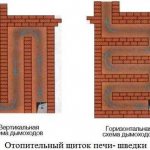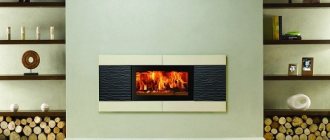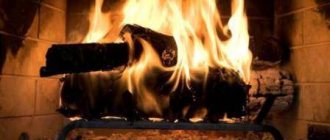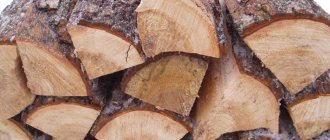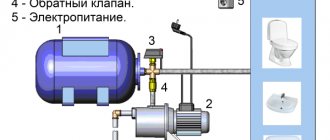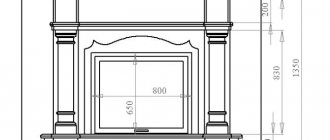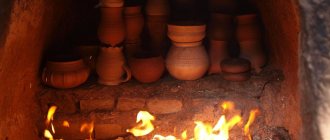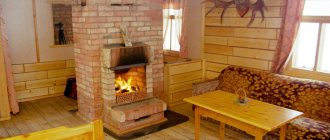Do-it-yourself Swedish stove with three heating modes
Swedish stoves differ from other heating and cooking stoves by the presence of a heating shield in the rear part. In this brick shield, a system of gas ducts is arranged: from vertical or horizontal. The smoke passing through them heats up the structure, and the premises are already heated from it. The system turns out to be efficient and economical: the heat that went into the chimney in a traditional Russian stove is used to heat the premises. But both systems for building a shield (vertical and horizontal) have disadvantages.
With the horizontal arrangement of the gas ducts, the entire flap heats up evenly. But, such a system requires a large number of cleaning holes and, accordingly, doors on them. Considering that furnace casting is not cheap today, these doors significantly affect the final cost.

Heating plate for a Swedish oven with horizontal and vertical flue ducts
With a vertical arrangement of gas ducts in Swedish, there can be one cleaning hatch. But there is another problem: while the furnace is being heated, in the first channel, on the side where the hot gases from the furnace enter, the shield will be noticeably hotter than in the third - at the outlet. Since the shield is usually located in two rooms, one of them will be much warmer than the other.
There is also a third type of flap device: bell-type. It combines the advantages of both systems: one cleaning window is required, the entire surface warms up evenly, and less brick is required for construction. Moreover, with such a construction, the furnace cools down more slowly: the warmest air is kept in the tops of the hoods for a long time, and the "draft" from the doors passes only in the center.
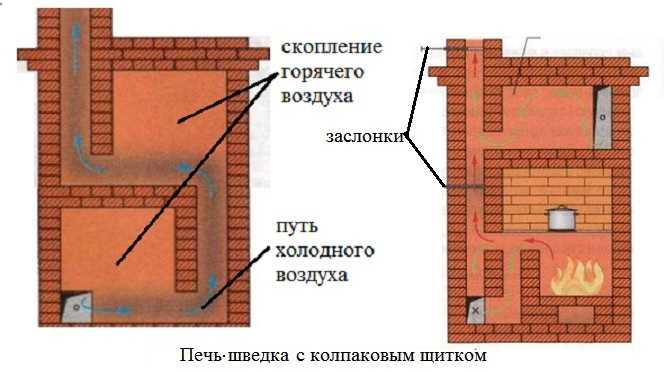

When using the hood principle of construction of the shield, the heat is retained longer
From all that has been said above, it follows that the most economical and effective Swedes with shields built according to the bell principle. They are easier to control: it is possible to organize a "summer" and "winter" mode of operation, in which only a small part of the shield is switched on (in summer) or the heating power weighs in: in winter. There is even a variant of a Swedish stove with three combustion modes: an "autumn" mode is added, in which a little more than half of the chimney channels participate in the smoke circulation.
General Provisions
Ceramic brick
For the laying of stoves and fireplaces, solid ceramic bricks of the 100-200 grade are used. The main criteria for determining the quality of a red ceramic brick are: 1) the absence or a small number of small hairline cracks on its surface; 2) uniform firing (the same color) in its entire mass, which is determined when the brick is split in half.
Refractory bricks Fireclay (ША-8, ШБ-8, ШВ-8) bricks have dimensions of 250х124х65 mm. Note: the indexes "A", "B", "B" mean the degree of refractoriness of the brick.
They are used for lining fireboxes: 1) stoves that will be operated in a long-term mode - stoves that do not have a brick overlap of the firebox (kitchen stoves of all types, barbecue fireboxes). Cooking stoves are also lined to reduce the size of the firebox, i.e. optimizing the amount of firewood bookmarks; 2) furnaces operating on high-calorific fuel (coal, diesel fuel, gas); 3) large household stoves with a capacity of over 3000 watts.
It is prohibited to use hollow (slotted) and silicate bricks for laying furnaces. When laying fireplaces, it is allowed to use finishing slotted ceramic bricks in places that are not the walls of the firebox, smoke collector, chimney, otter.These places are: the second circuit of the firebox with a thermal gap device, fireplace shelves, niches, peripheral cutting rows.
To improve the appearance of stoves and fireplaces, solid ceramic bricks with radially rounded corners () can be used.
Part 2: A beginner's guide to stove-makers
Chapter 10 Clay, Sand, Water and Additives
In the first part of the book, I already briefly talked about a number of parameters by which you need to choose clay, sand and brick. Here, I will only supplement this information with information necessary for every stove-maker.
Before packing fresh clay for transportation to the place of work, you should first assess its quality
It is important to know that too oily clay and clay, even with the slightest presence of stones, will increase the laboriousness of preparing the oven solution (with manual mixing). Too skinny clay will seriously weaken the strength of the furnace seam.
And clay, heterogeneously deposited in the soil or with admixtures of earth and foreign fractions, will create inevitable problems in the preparation of a high-quality furnace solution.
Excessively greasy clay
to the touch it resembles very sticky plasticine. It is impossible to tear off freshly cut plastic of such clay from a shovel with either hands or feet. It can only be cleaned with an additional small spatula or trowel. Such clay will give a ratio of clay to sand from 1: 4.5 to 1: 6. The oven solution after the hardening time will be very strong, but in the absence of an electric clay mixture, the process of preparing a high-quality oven solution (manual mixing) will be extremely laborious.
Taken out of the ground overly skinny clay
by its properties it is more reminiscent of sticky dusty sand. The stickiness of this material is very low. However, if there is no choice, what to do. There is no need to add sand to such clay. The above two types of clay are very rare in central Russia.
Medium fat clay
gives (in the overwhelming majority of cases) the ratio of clay and sand 1: 1.5 and 1: 2 (and very infrequently 1: 2.5 and 1: 3).
The rules for using sand and water are detailed in chapter 1.
Additives
... Abroad, some stove-makers traditionally add 10-15% cement to the mortar. Table salt is also recommended (100-200 g per 10 liters of water). However, according to my many years of observation of the processes taking place in the oven masonry, a well-tested clay-sand oven solution does not need any special additives. He will be strong enough anyway. And if the furnace firebox and the adjacent zones breaks apart at the seams due to severe temperature changes, then not some special additive is needed, but a special procedure for laying bricks in the furnace (lining). The lining proven over the centuries and the competent selection of the cross-section of the smoke channels (see chapters 15 and 28) will protect the furnace from serious ruptures in the furnace seams more reliably than the use of some special additives, and even more the wire binding of the furnace.
I also heard about some particularly complex and even "secret" additives in the most intricate compositions and proportions: ash, cement, chicken eggs, etc. But I did not consider it necessary to show interest in them.
Experience shows that the best "additive" for furnace mortars is the ability to correctly select the ratio of clay, sand and water, as well as the reasonable use of fireclay mixture and fireclay bricks in cases where technical standards and common sense require it.
... For more details, see paragraph 13 of Chapter 18 of this book.
Optimal dimensions of the firebox
To determine the optimal dimensions of the furnace furnace, you need to determine the type of fuel.
For firewood
The height of the firebox varies from 0.8 - 1 meter, so that volatile substances have time to burn in the firebox and soot deposits do not form in the chimney. Width from 0.25 to 0.4 m and minimum depth 0.7 m.The corners of the bricks that are in contact with the grate must be angled towards the grate so that the coals can roll off.
For pellets and briquettes
This type of fuel is quite versatile and suitable for use in a conventional stove. Furnace parameters: height from 0.8 to 1 m, width from 0.25 to 0.4 m, depth from 0.7 m. The difference is that briquettes are made from waste. They are processed and pressed into briquettes of various sizes and shapes. Suitable for heating houses and non-residential buildings.
For coal
For productive combustion of coal, a large amount of oxygen is needed than when burning briquettes. For this reason, the area of the grate is larger than the dimensions of the firewood stove.
The depth of the grate is at least 0.3 m, the height is from 0.8 to 1 m, the width is up to 0.4 m. The grate section is also taken into account, because the temperature during coal combustion is much higher than when burning peat or pallets.
For peat
The height of the furnace varies 0.70 - 0.80 m, width 0.25 - 0.3 m, depth from 0.7 m.The parameters of the grate depend on the amount of moisture in the peat: when using dry peat, the same grate is placed as for conventional heating, for wet peat, the grate should be larger. The slots in the grill should be no more than 1 cm.
For a sauna stove
If you put a heating device in a bath with high efficiency, then the room will be warmed up quickly, and the stones will not have time to reach the desired temperature and steam will not work. A firebox with a low efficiency can lead to burnout of the metal, due to operation at maximum temperature.
The optimal size of the furnace for a sauna stove is 650x650 mm. This parameter will allow you to get a power of about 30 kW. And if you set the height from 1 to 1.5 meters, then the number of stones placed in the stove will be from 70 to 150 kg.
Design features of our ovens
With a wide variety of stoves, it is impossible to use only one single smoke circulation system in them - each stove has its own dimensions, purpose, and other features, on the basis of which one or another smoke circulation system that is most appropriate for a given furnace is used: 1) The advantage of a channel smoke circulation system is the ability to direct the first, hottest flue gases along the lower part of the furnace, and the disadvantage is the inability to provide good conditions for traction due to the large length of the channels. Vertical ducts are of limited use due to the fact that they require good conditions for draft (from the grate to the head of the pipe at least 6 meters) due to the long distance of the downward movement of flue gases. In kitchen hearths and large heating and cooking stoves, the use of a duct system with vertical smoke flows is justified in high one-story houses and on the first floors of two-story houses, because the flue gases move slowly here and manage to heat up the furnace mass well (high efficiency). Under good conditions for draft, horizontal channels with a minimum (one or two) number of revolutions are used in large heating, heating and cooking stoves and heating shields of Russian stoves. In kitchen hearths and small heating and cooking stoves with good draft, the use of horizontal smoke flows is unjustified. Flue gases move quickly here (excessively strong draft) and the furnace mass heats up weakly, which leads to excessive consumption of firewood (low efficiency). The disadvantage is that these furnaces have to arrange a large number of clean holes. In rooms with low ceilings (small garden houses, temporary huts, garages, etc.), where the distance from the grate to the pipe head is less than 5 meters, the only option in all types of furnaces is to use horizontal channels. Weak draft in this case allows the flue gases to move slowly and warm up the furnace mass well; 2) In the bell-type smoke circulation system, the flue gases first go up and the already cooled ones go down the “bell”. The draft in the furnaces of the bell system is confident, but the main disadvantage in large furnaces is overheating of the upper part and weak heating of the lower part. We found the application of this system in small stoves, where the walls of the firebox are the outer walls, and above the firebox there is a bell-type convector.Heating of the surface of such furnaces occurs evenly over the entire height, which is the main requirement for furnace heating; 3) Heating and cooking and heating stoves, with the location of the smoke channels on the sides of the firebox, are designed using a combined system of smoke circulation, including a channel and bell systems. The combined smoke circulation system is devoid of the disadvantages of duct and bell systems, because the first hot flue gases through the channels first pass along the lower part of the furnace (a small length of channels), and then enter the bell-type convector located in its upper part. This ensures uniform heating of the entire surface of the furnace; 4) A common type of stove heating is heating and cooking stoves and kitchen hearths, which are most suitable for the two-level smoke circulation system developed by us and tested over many years of operation. With this movement system, the first, hottest flue gases first enter the lower half of the heating shield and heat it up to the upper half. At the same time, the surface over the entire height of the shield heats up evenly, and the heat transfer to the room due to predominantly lower heating is much better than in kitchen hearths with vertical smoke flows, where the top of the furnaces is heated to a greater extent (the effect of the bell system).
Of great importance in the design of stoves is the binding system, which means the arrangement of bricks in the masonry relative to each other, their combination between the outer and inner walls, in the overlap of the firebox, the ceiling and other elements of the stove. A good dressing system ensures the durability of the furnace, its operability throughout the entire period of operation and fire safety, i.e. the tendency to burnouts between the outer and inner walls of the masonry is excluded, in which the flue gases would not go through the smoke flows, but would break through by a short path from the firebox into the chimney, leaving a significant area of the furnace surface cold ().
Furnace devices of furnaces-3
FIREWOOD FUELS
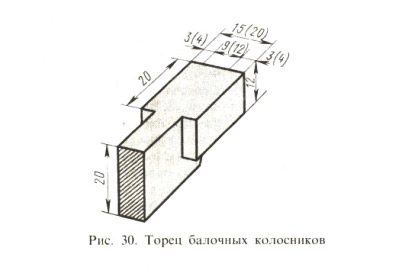

For burning wood fuel, fireboxes are used (Fig. 33) with fixed grates 7, laid with a minimum slope to the front of the stove. Slopes are laid out from the grate to the walls of the furnace (ramps 2), which contributes to the rolling of coals onto the grate in the process of burning firewood.
The overall dimensions of the firebox are determined by the conditions that ensure complete combustion of the estimated amount of fuel, i.e., the conditions that ensure the optimal specific thermal stress of the furnace volume. The minimum height of the firebox overlap above the fuel layer is also limited; it must be at least 210, 280 and 420 mm for fireboxes with a heating capacity of 1800, 3500, 4000 W and more, respectively.
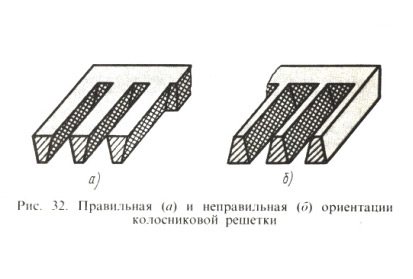

react with air within the combustion chamber. Thus, conditions are created for the full use of fuel. If the height of the firebox is insufficient (Fig. 34, b), the combustion process proceeds sluggishly; volatile substances, not having time to burn in the furnace volume, fill the gas duct. Due to low temperatures in the gas duct, the combustion process stops. This leads to the fact that unburned particles are deposited on the planes of the channels, forming a layer of soot, which significantly worsens the accumulation of heat by the furnace mass. A stove with a low firebox is uneconomical. In order for the combustion to proceed most efficiently, the thickness of the layer of wood fuel should be 200, 250 and 350 mm, respectively, for fireboxes with a heating capacity of 1800, 3500, 4000 W and more. The thermal voltage of the furnace volume of fireboxes for firewood should not exceed 400 kW / m3.
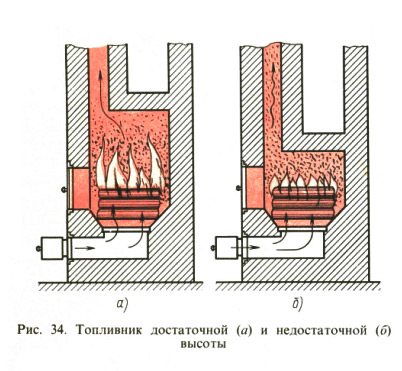

The depth of the firebox for firewood should be such that the logs are laid horizontally, but not less than 350 mm. The height of the ramps rising above the grate is 65 mm.The loading door should be of a height suitable for stacking firewood with a layer of about 300 mm.
Firewood stoves with a heating capacity of more than 3000 W are lined with fireclay bricks inside, which increases the durability of the stove. If the heating capacity of the firebox is less than 3000 W, the lining is not required.
FUELS FOR PEAT
Peat can be burned in fireboxes equipped with the same grates as wood-burning ones. However, such fireboxes are effective only for burning peat briquettes and cut peat that has been dried for a long time. For burning wet peat and peat chips, which require preliminary drying before entering the combustion zone, fireboxes are used, which are called semi-mine. The semi-shaft firebox (Fig. 35, a) consists of a horizontal grate 7, to which a steeply inclined grate is adjacent 2. Two or three doors are installed in the front wall of the furnace: blower 3, skimming 4 and loading 5. When peat burns, gases are released in the layer , which, mixing with atmospheric oxygen, ignite and burn in the combustion chamber. Wet peat, in addition, in the process of drying on the grate 2 gives off a large amount of water vapor. The evaporated moisture and flue gases are removed by the shortest route through a small gap 6, 65 mm high, located in the ceiling of the combustion chamber or under its roof. The area of the slot is 3 ... 5% of the area of the horizontal grate.
In cases where the firebox for burning peat has an outlet to the smoke circulation system directly through the ceiling, for example, when working on dry peat (Fig. 35.6), the steam outlet is not suitable. When firing up the furnace, a small amount of peat is loaded onto a horizontal grate using


skewer door 4. As the flame has ignited, small portions of fresh fuel are added through the loading door 5. When the layer of burning peat reaches the base of the steeply inclined grate 2, the firebox is filled with a full portion of fuel to the level of the upper door. The grate of the peat-fired firebox must have slots no more than 10 mm wide.
FUELS FOR COALS
Fuel boxes for brown coal. Brown coals are characterized by a very high ash content (12% or more) and high moisture content (up to 45%). To burn this type of fuel, use the firebox shown in Fig. 36, a. Similar to the peat firebox, it is equipped with horizontal 1 and inclined 2 grates. Grid inclination 2 30 °. The firebox is equipped with four doors: blower 3, ignition-shurovochny 4, cleaning 5 and loading 7. Doors are located in two opposite walls of the furnace - front and rear. The ash-pan 8 of the firebox must contain a significant amount of non-combustible mass of fuel. The loading door is positioned 1000 mm above the grate /. A vault b is placed above the firebox, which contributes to a more complete burnout of coals. The minimum height of the firebox with a heating capacity of up to 3500 W is 490 mm, with a higher heating capacity - 630 mm.
With a small heating capacity (up to 3500 W) of the furnace, the firebox for brown coal has a simpler design (Fig. 36.6). Fireboxes for hard coal. Most bituminous coals require much more air to enter the firebox for combustion than when burning wood (about 70%). In this regard, the free area and the area of the grate at the fireboxes for burning coal must also be large. The grates of such grates are higher in comparison with grates of grates for firewood, otherwise they will deform from the thermal stress arising from burning coal.
The firebox (Fig. 37) consists of a grate 1, a blower 2 and a loading 3 doors, a vault 4, an opening for the removal of combustion products connecting the combustion space with a gas duct 5. The inner walls of the firebox are lined with refractory bricks 6.The smallest height of the firebox above the fuel layer is, mm: for coals near Moscow - 500, for stone - 400; the thickness of the fuel layer should be between 90 and 200 mm.
Fuel boxes for anthracite. For efficient combustion of anthracite, a thick layer of fuel is required, in which a sufficiently high temperature of hot coals can develop. Anthracite burns with a small flame, with a low release of volatiles. Therefore, the volume of the firebox for anthracite can be almost 2 times less than the firebox for firewood. The process of burning anthracite takes place without its frequent shura. Anthracite does not bake, the products of its non-combustible mass are easily separated and fall into the ash pan.
The firebox for anthracite (Fig. 38) is made in the form of a shallow furnace shaft 3, located in the hearth. The base of the shaft is completely covered by a grate 2 with a small free area (about 10%). The walls of the firebox are completely laid out of refractory bricks 5. The mine firebox for anthracite, shown in fig. 39, a, provides long-term fuel combustion. It is possible to simultaneously load a large amount of fuel into such fireboxes, sufficient for a period of combustion for 15 ... 20 hours. Due to this, there is no need for a heat-accumulating mass of the furnace.
the volume of air supplied for combustion through the blowing door 3. The fuel is loaded into the shaft 5 of the firebox through the door b onto a layer 2 burning over the entire area of the grate.
When anthracite burns, a very dense slag is sometimes formed, which is difficult to remove from the grate. To eliminate this phenomenon, the slag is "steamed" by supplying water vapor under the grate, which is formed in the baking tray 1 installed in the ash pan, filled with water. The air-steam mixture formed in the shaft 5 during the fuel drying process is removed through the opening 7. Some fireboxes for anthracite are equipped with movable grates (Fig. 39.5), which facilitates the operation of the furnaces.


SPECIAL FUELS
Fireboxes for sawdust and husk. These fuels are efficiently burned in specially designed fireboxes. Such fireboxes (Fig. 40, a) are equipped with a blind hearth 1, on which a grating 2 is installed in the form of a truncated half-cone made of sheet steel (Fig. 40, b). Holes with a diameter of 6 mm are drilled in the cone at a distance of 30 ... 40 mm from one another. Instead of the furnace door, a hopper 4 is placed on the furnace, into which fuel is loaded, moving along the chute 3 under its own weight to the hearth of the furnace. When they catch fire at the hearth, husks or sawdust are taken up by a stream of air and burned on the fly in the furnace space. Straw and husk are long-flame types of fuel, therefore the height of the furnace is 500 ... 700 mm, which is almost 4 times more than that of the anthracite firebox. The use of fireboxes of the described design allows saving a large amount of valuable types of fuel due to the use of production wastes.
Fireboxes for dung. In the regions of our country, where farms have a significant number of ruminants, it is advisable to use dung with a calorific value of 10 ... 12 thousand kJ / kg as fuel. It is especially rational to use dung in the southern regions, where it is easy to organize its preparation and natural drying. Dung burns with a smoldering flame like charcoal, but the release of volatiles is significant.


Dung, the moisture content of which reaches 30%, is burned in fireboxes, the design of which is similar to fireboxes for peat (Fig. 41). In order for small particles of dung not to fall into the ash pan /, the gaps in the grates 2 and 4 should not exceed 10 mm. The fuel is dried on a steeply inclined grate 4.
The thickness of the fuel layer is maintained in the range from 150 to 200 mm. Steam comes out through hole 6. The height of the firebox above the fuel layer should not exceed 400 mm.The smoke from the firebox is discharged through the rear 7 or 8 side channel.
UNIVERSAL FUELS
Prefabricated stoves use universal fireboxes, which are suitable for burning various types of fuel. The production of ready-made stoves and standard parts for their assembly at construction sites is most facilitated by fireboxes, the back wall of which is made with a large opening (pass). A mine firebox with a pass and a semi-vault is shown in Fig. 42, a. A characteristic feature of such a firebox is the absence of overlap over it. The overlap was replaced by an inclined baffle plate (semi-dome 7).
The stove is located in the firebox slightly below the usual vault, which enhances its reflectivity and creates conditions for burning various types of solid fuels. The tightness of the firebox is increased by its lining, into which the loading 1 and blower 2 doors are mounted. The slopes 4 of the firebox form a depression in which the grate 3 is installed. The dimensions of the grate and its free cross-section are such that they allow the burning of firewood, peat, coal and various types of local fuel (brushwood, straw, wood waste). This versatility of the firebox affects its average efficiency, which ranges from 75 (when burning coal) to 45% (when working on local fuel).


A firebox with a baffle plate is technologically advanced in production, since the brickwork is replaced by an assembly of elements of refractory 10 and ceramic 9 plates, lined with tiles 11. The combustion process is intensified due to the reverse vault 8 located above the fire door, which contributes to the formation of vortices of the gas flow. Reflected from the reverse vault, the flue gases go around the semi-vault 7 and descend between the pass 5 and the rear wall b of the firebox.
In our country, brick universal fireboxes are used (Fig. 42.6) with an increased furnace space, which makes it possible, along with fuel that has a low release of volatile substances, to burn wood and peat. The gases released in the firebox go around the pass 5, then descend through the first furnace channel 12, enter the lifting channel 13 and go into the convective system located above the ceiling 14. Coals, for example anthracite, burn in the firebox with the pass much worse than in the firebox with a mine ...
The advantage of universal fireboxes is a strong heating of their walls, which is due to the location of the smoke flows located directly at the pass. The increased heat transfer of the furnace and underfloor parts of the furnaces ensures good heating of the lower zone of the premises. Thanks to this, comfortable conditions are created in the living rooms of the heated building.
COMPLEX CALCULATION OF FUELS
Calculating a firebox means determining the optimal dimensions of all its elements: the volume of the firebox, the dimensions of the grate and the blowing hole.
Example. Calculate the firebox for coal from the Azeiskoye deposit with a lower calorific value Qpн = 5 16 500 kJ / kg. Efficiency: firebox ηt = 0.9, stove ηp = 0.6; convective system ηk = 0.666. The heat transfer of the furnace must cover the heat loss of the premises Qpch = = 2500 W. The firebox must generate an amount of heat sufficient to heat the premises for one two-hour furnace (z = 2 hours) per day, since the heated building is located in the northeastern zone of the BAM.
Decision. With one two-hour furnace per day (24 hours), coal must be consumed for each hour of the furnace
Bh = (24 * 3.6Qph) / (zQpнηн) = (2.4 * 3.6 * 2500) / (2 * 16500 * 0.6) = 10.91 kg / h.
where 3.6 is the conversion factor.
The amount of heat generated in the firebox during 1 hour should be Qh = (2500 • 24): 2 = 30,000 W.
"Previous table of contents next"
How to build a stove
The layout of a brick oven is a sequence of actions. Compliance with them is essential.The material needs processing and precise styling in order to avoid flaws as much as possible, which will then affect functionality. The stove is a heavy structure that needs a solid concrete foundation, which must be insulated with roofing material. If the house is already built on a monolithic foundation, which makes up the entire floor area, you do not need to make a special foundation for the oven.
The work should begin with the fact that a row of bricks or large crushed stone is laid, which is covered with mortar and smoothed. The next row will already make up the oven. Experts advise, for a start, lay out the bricks in the place where it is supposed to lie in order to fit all the dimensions and exact location. Also, you need to soak each one in water for ten minutes. If fireclay is used, then it is enough to wipe it with a wet rag. Before starting work, you need to calculate where the chimney will go. If the construction takes place in an already finished building, it is worth calculating the place so that it is convenient to make a hole in the roof and interfloor ceilings.
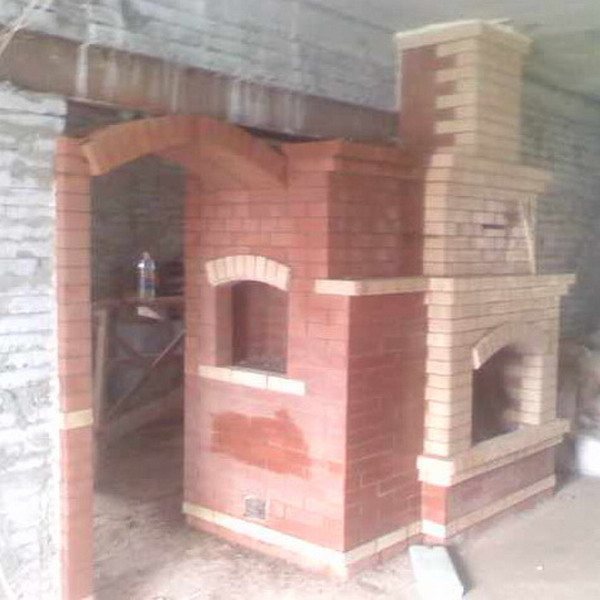

The first row is laid out so that the horizontal lines are oriented along one of the walls. In the place where the stove is as close as possible to the walls, you need to lay out the second brick. This will ensure fire safety. A metal grate is installed in place of the firebox. There will be several of them in the design. One of them will share the firebox with a compartment for collecting ash. In the second row, take into account the free space for the chimney and the connector in the masonry under the lower door. There will be two of them. Small - for cleaning ash, the second - opens the firebox and has a large size. The doors are securely fixed with a wire between the bricks and smooth the joint with mortar. After the third row, you need to lay out two rows of bricks on a spoon, cover it with a number of fireclay refractory bricks. This will serve as the basis for the firebox grate. After that, the door of the future firebox is strengthened, and its walls are laid out. The vault is formed from fireclay bricks. There will be a fireplace next to the firebox.
This design requires significant reinforcement. This can be achieved by laying horizontal metal corners, securing them with refractory bricks. The fireplace grate is flush with the masonry. When this part of the stove is ready, they begin to lay out the chimney and divide it into wells. The arch of the fireplace is laid so that it goes over to the chimney. At this stage, after the formation of the first row of its walls, the space is divided into wells, the doors are fixed, with the help of which the soot is removed from the chimney. When everything is ready, the previously removed bricks that formed the wells are returned and fixed with mortar. The chimney is laid out to the very ceiling, periodically laying the reinforcement
It is very important to make empty space and cornice under the top. A sheet of tin is placed on top of the wells, fixed with two rows of masonry
This work is already being done in the attic. Here the chimney is divided into two compartments, to each of which valves are mounted. The walls of the chimney, which comes from the stove, need to be strengthened and when it reaches the roof, bring it out slightly above the ridge.
Parameters when using peat
Experts note that the combustion process of wood fuel takes place with the consumption of less oxygen than coal requires. Based on this, it is necessary to take into account the fact that the dimensions of the grate area in furnaces where this type of fuel is used must be larger.
In the combustion area, in the combustion chamber, conditions for maximum oxygen penetration must be created. That is why a grate of the same size as the bottom of the chamber is installed for coal.


Definitely a large coal stove
As for the material of manufacture of this element, it must be resistant to high temperatures, and also have a thickness of at least 4 cm.Experts note that if the stoves have hobs, then the fuel can be loaded through the holes in them.
For coal of the "Anthracite" brand, a characteristic feature is that the volume of volatile substances is much less than that of other bituminous coal or firewood. Accordingly, under such conditions, a small flame burns inside the furnace, which makes it possible to reduce the size of the furnace by almost half.
The immersion depth of the grate should be 30 cm, and in order to increase the efficiency when using coal of this grade, it is necessary to narrow the firebox in the area of the lower part of the grate. The fuel layer will be larger, and hence the heat transfer will increase.
The calculation of the sufficient volume of the furnace in which peat is used is based on the recommended parameters of the chamber height, corresponding to an average of 75 cm, fluctuating by 5 cm up or down.
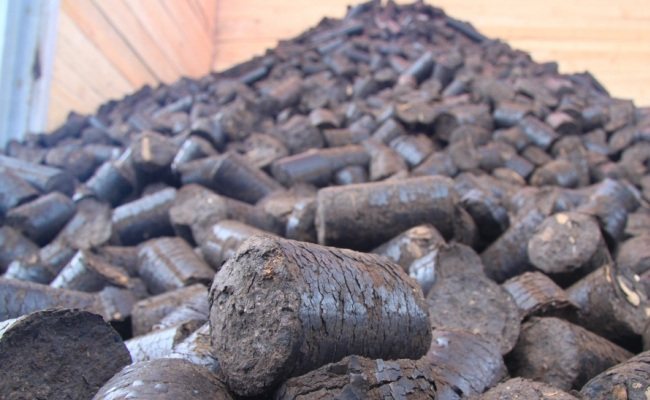

Peat briquettes from the press
Depending on how wet the peat is, the size of the grate will differ. If the briquettes are dry, then the same element is suitable as for wood-burning stoves, but if the product is wet, then it should be slightly larger. The length of the gaps is between 0.8-1 cm.
If the peat is wet, then for a room or sauna stove it is necessary to choose a larger grate, since here it is recommended to use a furnace height of at least 80 cm, with a width of 40 cm. You will also have to drill additional holes in the valve.
Depending on the selected type of fuel, the size of the furnace and the volume of material for one tab will be determined:
- If measured from the grate, the height of the combustion chamber should be about 65 cm (if using peat), 80 cm (if using firewood) and about 70 cm for coal.
- The width of the firebox in small stoves is about 20 cm, for large structures 30 cm will be enough.
If you rely on the recommendations given regarding the requirements for the fuel used and the parameters of the combustion chamber, then you can avoid overconsumption of materials, thereby saving a decent amount during the heating season.
Furnace ordering
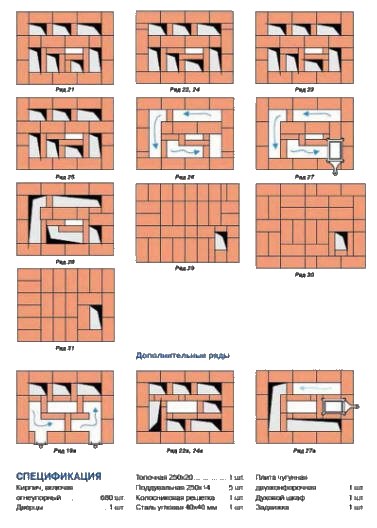

Before you start laying the oven yourself, follow a few simple preparatory steps.
Soak the brick first. To do this, the bricks need to be dipped in clean water and left there for about a day. Water will fill the pores in the brick structure. Due to this, in the future, the building material will not absorb water from the clay mortar.
Prepare a clay solution. It will consist of ground clay, some sand and clean water. The specific ratio of the components is selected in accordance with the characteristics of the clay.
It is important that the finished solution has normal plasticity and a homogeneous structure. On average, it takes about 20 liters of mortar to lay hundreds of bricks.
1 row. It was previously noted that this row should be laid out exclusively at the building level with additional verification using a square. Lay out this row in solid masonry. Inside, the use of halves of bricks is allowed.
2 row. Lay out in the same way as the 1st row. Be careful and do everything in strict accordance with the technology, because the first two rows serve as the base of the furnace, which should be as reliable as possible.
3-4 rows. Continue laying, gradually forming the ash chamber. At the same stage of masonry, the door of the said chamber is installed. Additionally, 3 doors for cleaning hatches and a door for a blower are mounted. On the back of the Swede, lay out the chimneys. They are placed in a vertical position and communicate with the combustion chamber through a hole, which is equipped in the process of laying out the furnace.
5 row. Install the finished oven and place the grate of a suitable size in it.Form an overlap for the cleaning hatches and the blower door.
6-10 row. Lay out the walls of the combustion chamber and oven. A partition made of fire-resistant bricks is laid between the combustion chamber and the oven. The brick must be laid out on the edge. The partition should be one row lower than the chamber itself. After the tenth row is ready, lay a standard steel corner and an additional cast iron plate from the front of the structure. Use steel wire and a 2 cm layer of clay to secure the corner.
11 row. Complete to the end the overlap of the channel through which the cast iron plate and the right wall of the furnace are separated.
12-16 row. Lay out the brewing compartment and 3 vertical flue pipes. Lay out the chimney holes from refractory bricks.
17-18 row. Form a cover over the brewing compartment. To form the overlap, use the sheet steel laid in the previous steps and a corner of the same material.
19-20 row. Attach 2 hatches for cleaning the flue gas ducts to the front of the door structure.
Row 21-28. Lay out the chimney ducts. Don't forget about bandaging your stitches. In the process of laying out 27 rows, install a convenient latch. Leave a technological hole above the installed smoke damper through which the gas ducts will be mated with the air ducts.
Row 29-30. Lay out the chimney overlap. At this stage, the width of the perimeter masonry must be increased by 50 mm. Thanks to this expansion, the cornice will be formed.
31 row. Bring the dimensions of the overlap to the structural dimensions of the 27th row.
32 row. Start laying out the chimney. The standard chimney design has dimensions equal to 130x250 mm.
At this, the layout of the oven can be considered complete. At the end, it remains only to complete the chimney device, and also, if desired, finish the stove, for example, with paint or ceramic tiles. Additionally, you can buy a variety of accessories, for example, for storing fuel.
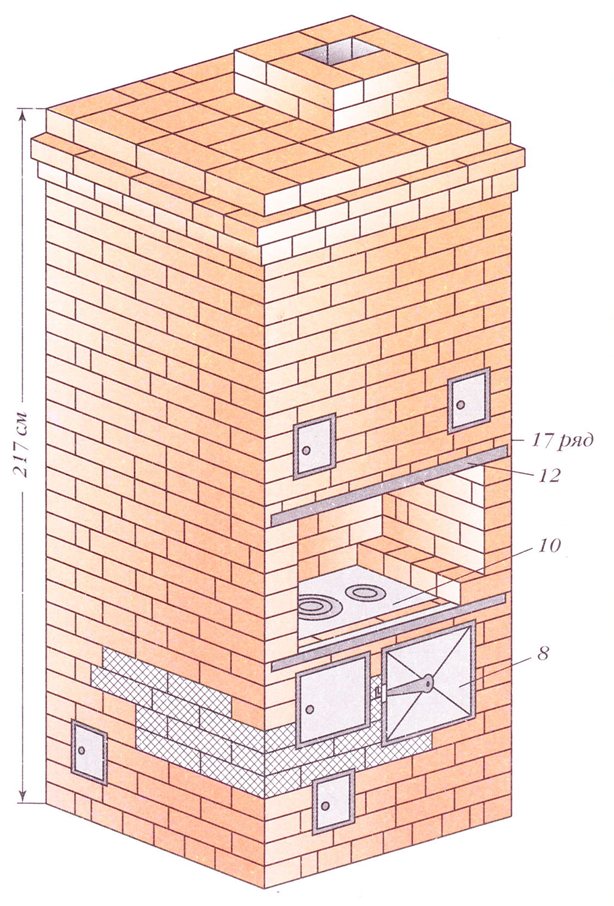

Stove Shvedka (front view)


Building a staircase in a house is not an easy process, but doable. The main difficulty lies in calculating the angle of inclination and parameters of the span, because not only ease of use depends on this, but also the durability of the structure. Strong and beautiful flatter ...
The device of fireboxes
Fuel tanks are arranged in accordance with the purpose and purpose of the device. Their shape and size are determined by the quality and quantity of combustible material applied at a time. In a fireplace, for example, a firebox consists of a niche or recess in the wall, or of three walls: the back one and two side walls, perpendicular to the first one or inclined to it to reflect radiant heat into the room. They put firewood on a lower blank plane, called a hearth, or on a firewood stand, as in French fireplaces. In English fireplaces heated with wood, a cast-iron box with an ash grate is inserted into the recess for free air flow to the fuel. In the vault above the recess, or in the back wall, an opening (hailo) is left for conducting combustion products into the chimney. In room and other appliances, a metal furnace door is embedded in the front wall of the firebox to put fuel and air flow to it. In hot water and other boilers, the vault is replaced by their bottom, in kitchen fireplaces, etc., by a cast-iron stove. An exceptional feature is the firebox of the Russian stove, which consists of a large depression inside the brick mass, with a wide hole on the front side through which firewood is placed into the cavity, air flows in and smoke flows out.


Materials for the Swedish stove
When creating this structure, two types of bricks are used: red and chamotte (refractory) - raw bricks are sometimes used instead. Before laying, the material is soaked in water for 24 hours. The foundation of the unit is laid on cement mortar, and the structure itself is laid on clay.The durability of the "Swede" depends on the quality of the clay mortar - the higher it is, the longer the stove will last.
Whatever the order of the Swedish stove, metal parts are necessarily present in the design - dampers, doors, latches. Most often they are made by the cast iron method. For floors, metal corners, reinforcing mesh, tires and metal sheets are used. Various finishing materials are often used, but the Swedish woman is usually simply painted with lime. But there are also structures decorated with decorative stone, tiles and other things.
To order the oven you will need:
- solution container;
- metal sieve with meshes of 1-2 millimeters;
- hammer;
- bayonet shovel;
- Master OK;
- plumb line;
- level.
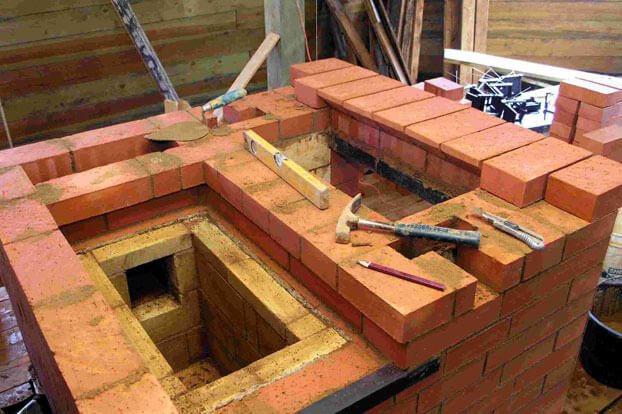

Calculation of the amount of bricks, clay and sand
The number of bricks per stove or fireplace is given in the project catalog and in the project documentation itself. The calculation of the total number of bricks for building a stove or fireplace is made up of: quantities according to the project + horizontal cutting + vertical cutting + pipe riser + otter. The calculation is shown in the table:
| Number of bricks per stove (fireplace) | Horizontal groove with internal section of the smoke channel | Vertical cuts | Pipe riser with an internal section of the smoke channel | Otter with internal section of the smoke channel | |||
| 130x130 mm | 130x260 mm | 130x130 mm | 130x260 mm | 130x130 mm | 130x260 mm | ||
| Contained in the catalog of projects and project documentation | 135 pcs. | 160 pcs. | The number of bricks on them depends on the installation of the furnace relative to the walls of the building. | 56 pcs. for 1 m / r. | 70 pcs. for 1 m / r. | 100 pieces. | 150 pcs. |
Consumption of clay and sand at the stage of their preparation: clay - 4-4.5 buckets; sand - 5 buckets per 100 bricks.
In projects of ovens with glass doors, their brands and e-mail addresses of purchase are indicated. The dimensions of the foundation should be wider in all directions by 50-100 mm. the dimensions of the oven in plan. The height of the foundation must be 140 mm lower than the finished floor. The concrete foundation is insulated with two layers of roofing material or roofing felt. The wooden foundation is insulated with felt dipped in clay milk. The distance from the stove ceiling to the unprotected wooden ceiling of the room must be at least 350 mm. The catalog indicates the minimum ceiling height of the room at which this stove can be installed. With a higher ceiling height in the project, the rows of the furnace masonry are indicated, which must be repeated. The height of the stoves in buildings with concrete slabs is not limited. Cooking stoves and trestle beds of heating and cooking stoves can be installed on a common foundation and with their installation on a pre-reinforced floor: 1) when installing a stove with a trestle bed and a heating shield with a stove on a common foundation, they can be tied into a single body; 2) if the kitchen stove or trestle bed of the kitchen hearth is installed on a pre-reinforced floor, and the heating shield or stove is installed on a foundation resting on the ground, then they cannot be tied up into a single body due to the settlement of the foundation. At the same time, the floor under the slab or trestle bed is insulated with two layers of felt dipped in clay milk, which are covered with a sheet of roofing steel. In this case, the weight of the stove or trestle bed should not exceed 700 kg. To reduce the weight of the trestle bed, the side walls can be laid out of heat-resistant foam concrete blocks (bricks).
Dimensions of the furnace and ash chamber of a traditional brick oven
Tell me the correct dimensions for the ash, furnace and baking chambers for a rustic brick stove. What is the best door size to choose.
The specialist stove-maker answers:
The dimensions of the furnace furnace, in order to ensure positive characteristics, must be within these limits. Each deviation will negatively affect the combustion process and reduce the efficiency of the furnace. These are the first rules for performing oven masonry.
ASH CHAMBER
The air flow coming from the ash chamber through the grate into the furnace should participate as much as possible in the combustion process. The amount of air not participating in combustion reduces the temperature in the furnace and, as a result, the efficiency (efficiency) of combustion. A decrease in the temperature in the furnace increases the consumption of firewood during the heating of the furnace to the optimum temperature. Therefore, the dimensions are as follows: the depth is two bricks (140 mm), the width is 200-250 mm, the length from the door to the back wall is 300-350 mm. Grate 200 × 300 mm.
FURNACE FURNACE
Width 250-400 mm, depth (from door to rear wall) not less than 700 mm, height from 800 to 1000 mm. The specified dimensions will ensure the complete combustion of hydrocarbons (combustible gases), which will allow the maximum temperature in the furnace to be reached. And this will allow you to quickly warm up the furnace mass in a shorter period of time and consume less firewood.
FURNER DOOR SIZE
The width is equal to or slightly narrower than the width of the firebox. Height: 210-280 mm. The size of the hearth in the crucible of a Russian stove depends on the purpose of the stove. What and in what size dishes will be cooked. A clear understanding of the purpose of the oven (heating, cooking, shape, design, etc.) will help you make the right decision. The multifunctionality of the stove structure does not oblige, but will allow to satisfy the interests of all family members in the process of changing age interests.
See also:
Stove heating of a country house
Brick stove-heater in the bath
How to eliminate the causes of smoking in the stove
More on topic OVENS FIREPLACES
It is important to comply with fire safety rules and regulations. And exclude 21 reasons for the smoke of the stove. Any negative manifestation during the firebox is the outer side, indicating unsatisfactory performance. There are many more rules and regulations that must be followed.
Any project is individual and requires a serious and responsible approach from the customer at the stage of discussion and choice. The ability to understand, hear and listen insures against ill-considered and hasty decisions.
The centuries-old experience of our ancestors has turned into wisdom, which claims that you need to dance from the stove. And you can't argue with that. You need to think over and decide everything before starting work.
Vladimir Ivanovich Chernoskutov, kiln master
Furnace design procedure
The layout of the stove in question is carried out in accordance with the order. This, as already noted, is a special diagram on which the order of laying out each row of the structure is indicated. There are standard orders. In the absence of skills in laying out stoves, it is strongly recommended to use exactly one of the standard schemes.
A well-designed order will allow you to significantly reduce the time and money spent on building a stove. The work will be carried out according to an accurate and easy-to-understand flowchart to maximize efficiency.
Having figured out the order of the Swedish stove before the start of construction, you will be able to lay out the unit on your own, without attracting third-party craftsmen to work and without spending money on paying for their labor.
In the expanded order, it is additionally indicated which materials and at what stage of work must be used.
Study the suggested ordering and additionally pay attention to the following points:
- The Swedish oven design includes a blower. This point must be remembered in the process of self-arrangement of the stove;
- the first row of bricks must be perfectly aligned. Any displacement will lead to the appearance of various violations that will negatively affect the quality and reliability of the finished furnace unit. To check the evenness of the masonry, use a building level;
- the correctness of the calculation of the angles must be checked - they must be strictly 90 degrees. Check the corners with the appropriate tool called a square.
The reliability, efficiency and durability of the Swedish stove largely depends on the correct layout of the first row, remember this.
Laying of fireboxes of all types of Russian and bread ovens
The lining and overlapping of the fireboxes of the stoves, where baked goods and other products are baked, are made with red ceramic bricks. Red brick gives a softer and more lasting heat (the lining here serves to accumulate internal heat) absorbs moisture well, compared to refractory bricks, which creates optimal conditions for baking, stewing and simmering products. Refractory brick, in comparison with red brick, has a denser structure, heats up faster to a higher temperature and cools down faster. This leads to the fact that in the fire chamber, where the lining and roof are made of refractory bricks, any baked goods quickly become crusty and under-baked inside. Moreover, in the humid environment of the fire chambers of Russian stoves, refractory bricks quickly collapse in layers, by the thickness of the absorbed moisture. This also applies to heating stoves with high humidity wood burning. The disadvantages of using refractory bricks include the fact that its thermal expansion is much higher than that of red bricks, and when the arch is supported on the main walls of the firebox, half a brick thick, they are subjected to greater stress and, for this reason, are short-lived.
How to heat the stove
There are two ways to fire a stove, one contradicting the other. Traditional - "bottom burning" - kindling at the bottom, large logs at the top. The flame passes through the entire bookmark, which leads to a steady combustion. The "top burning" method involves laying large logs down and kindling up. The fire is ignited from above and slowly spreads through the entire bookmark. During the upper ignition, until the combustion is established, the flame does not pass through the fuel layer, and volatiles (which cannot be burned due to the low temperature) are not emitted and which fly into the pipe, which occurs at the initial stages during the lower combustion. And when the fire spreads to the lower logs, they will begin to emit volatiles, which will fall into an intense, well-established flame, where they will burn. With the upper ignition, the wood burns up more slowly, but during the heating, the stove experiences lower thermal loads at each. Top burning works best if the stove is set to use “top air”.
Bottom air (left) Top air (right) a
- Primary air
b
- Secondary air
The set on fire should burn out to the end. Firewood is never added, and the door of the stove is opened only if necessary. If the stove is heated for a long time, then it will absorb heat faster than it will be released into the room. In this case, the oven could be irreparably damaged. Combustion should be as fast as possible, approximately two hours for an average burn. The valve should be closed as soon as the last embers have burned out. This prevents the oven from cooling down through the pipe. In the final stages of combustion, the valve can be gradually closed, focusing on the amount of remaining coals. The valve should have a 5% safety gap allowing little ventilation. By closing the valve, you need to be sure that the coals are burnt out, that an outbreak will not occur, and that smoke does not enter the room.
A brick oven burns wood quickly and vigorously. At the moment of ignition, the chimney damper and the primary air supply must be completely open. As soon as the fire has flared up and the walls of the firebox have heated up and the temperature of the flame has risen to 600 C, secondary combustion becomes possible.
View of the upper part of the furnace furnace one and a half hours after the start of the upper combustion.In the foreground there is a protective screen of the firebox lintel made of refractory bricks (suspended on metal brackets) and the stepped ceiling of the firebox.
In this case, all soot deposits burn out, and the inner surfaces of the firebox become white. If the furnace remains black after the fire has been burning for some time, then something has been done wrong.
Once the fire has started, the chimney damper can be partially closed if it is necessary to reduce the draft. The flame should be as light and yellow as possible, if the flame is dark red and purple, then the fire lacks air and the valve must be opened.
Well organized (powered) flame. Upper combustion, an hour after ignition, the secondary afterburning is clearly visible above the firewood. (Oak)
Secondary afterburning - Bread chamber "in black" (Video, 50 sec)
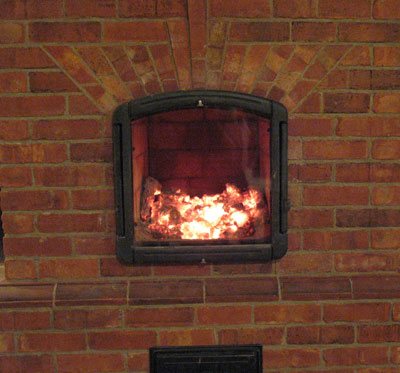

The bookmark shown above is burnt to embers. At this point, the valve is 90% closed. The cladding of the stoves, as a rule, is made of old bricks obtained from the dismantling of houses.
Primary air supply. Pyromasse ovens operate on "overhead air". It is fed through the blinds of the blower door, along the channel between the core and the cladding, and is deflected to the firewood at an angle of eighty degrees. Some of the early Pyromasse stoves used "bottom" air that passed through the grate and firewood. There seems to be agreement now that "overhead" air is preferable. "Bottom" (through the grate) air promotes too vigorous combustion and can lead to premature failure of the internal surfaces of the firebox. "Top" feed, provides enough air for maximum efficiency without forcing the furnace firing process. The ash-pan door, which has louvers, is located directly under the fire door and is used to supply “overhead” air from the living area.
Fire doors used by Pyromasse have one or two louvers located on the frame. They allow supplying secondary air to the firebox and performing secondary afterburning. These blinds can be closed at the same time as the shutter when the fire is out.
Reflectors of primary air in the firebox. (The shield of the firebox jumper on the brackets is also visible).
The stove can be fired one, two or even three times a day, depending on the weather. Although a permanent three-time firebox is not recommended. Make it a rule to wait at least 5 hours between fireboxes. Most stokers believe that one firebox per day is usually sufficient. You can make two medium furnaces a day instead of one big one. If it is not very cold, one firebox every two days is enough.
- Regardless of the number of fireboxes, a Pyromasse stove should burn no more than 100 pounds (45 kg) of wood per day.
- After setting fire to the bookmark, firewood cannot be loaded into the firebox.
- The pipe valve must be closed between the fireboxes.
- After lighting the stove, it is advisable to heat the whole season.
- It is advisable to first warm up a cold oven with a small tab, before heating it well. This will reduce the inevitable heat shock that occurs each time the oven is started.
- Never start a large fire in a cold oven.
- Never drown at the wrong time or for fun.
- The stoker must be weather-oriented, as the stove, once heated, remains warm for many hours or days, especially in mild weather.
- With each heating-cooling cycle, the furnace experiences a thermal shock. If the oven is used continuously, this shock is minimal.
- Ideally, the oven should be started at the beginning of the heating season and kept warm until the end.
- When used with respect, brick ovens will last a lifetime.
What material is better to use for well masonry
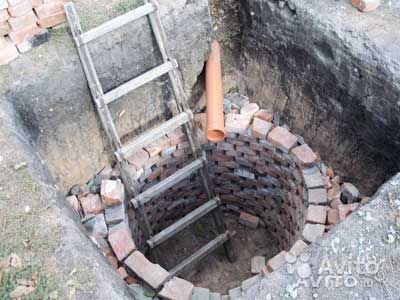

material and tools
First, choose the right construction tool, you will need:
- scapula
- hammer pickaxe
- ordering
- building level
- mortar shovel
- the rule
- cord mooring
- plumb line
- jointing
After checking the tool is available, you can start laying the well.
Well brickwork is made of ordinary ceramic bricks, silicate bricks are not suitable for a number of their characteristics. When laying bricks, decide on the masonry method. This can be the butt row or spoon method. Correct bandaging of the joints during brick laying is the key to the strength of the structure.
Round brick wells are laid in stitch rows. A poke is called the short side of the brick, respectively, the spoon is the long
It is important to properly lay brick lintels. When laying lintels, bricks are laid, narrowing inside and expanding outside
Seal the gaps between the bricks tightly with mortar, avoiding voids.
Brickwork technology
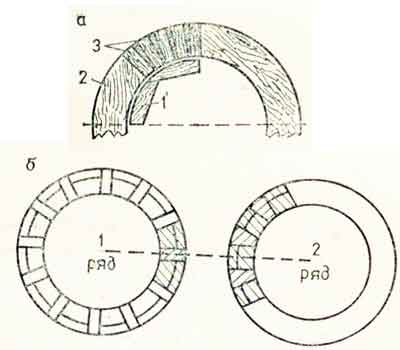

stages of laying a well
Before laying a brick well, a concrete base 10-15 cm thick is arranged. The soil under the base must be carefully leveled. Be sure to use level gauges.
Check carefully that the bottom of the well is horizontal. Make three round frames, the diameter of the upper one is 1 meter, the size of the lower frames increases proportionally. The two upper frames are made of wood, the lower frame is made of metal.
To be sure of the correct shape of the future well, make a template. With the help of hooks, it is attached to a brick row and the laying of a brick well will be calm and confident.
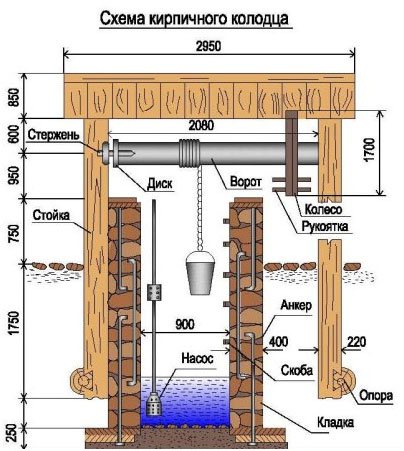

general sectional diagram of the well
If you use a template, even without professional skills, you will definitely complete all the work.
While laying, gradually raise the template to the next level of the row. To strengthen the brick layer, lay reinforcement every five rows. Lay reinforcement at a distance of 20-25 mm from the edge of the masonry.
Make sure that during the work the brickwork does not rest against the intermediate frame. Frames must be vertical and horizontal, their installation is checked with special devices. Check the level regularly during all work with a plumb line and a level. Place the brickwork at a distance of 50 mm, lay the area between the brickwork and the frame with mortar, to save and strength the mortar, fill in crushed stone.
Consider the following points when laying:
- The freshly laid mortar should be carefully compacted so that there are no gaps and voids. Then you need to squeeze the frame to fit snugly against it.
- If water is supposed to come from the side holes, provide small holes in advance for fixing the filters at the bottom of the masonry, filtration takes place by inserting porous concrete.
- Both outside and inside the brickwork, a layer of plaster must be applied. For the outside, it is necessary to take into account the dimensions of the pit in which the brickwork is made with a well. For the inner wall, the final diameter of the well. The solution is taken at the rate of 1: 1 or 1: 2 and is produced quickly, the longer the solution is idle, the weaker the plaster in consequence.
example well diagram
- When laying a rounded well, a gradual narrowing is made towards the top of the structure. To do this, the transition from the bottom to the top of the well is done with a gradual overlap of up to 3 cm. The narrowing is made from three sides of the well, leaving the fourth side vertical along the entire height of the masonry. Running brackets are provided on this side. They are built into a brick wall in a checkerboard pattern along the way and form a staircase. For a long service life, the staples, before embedding them in the brick wall of the well, are painted with waterproof paint.
Never forget about the rules for operating a well. Sometimes there is a need to clean the well and it is necessary to go down into the mine. Before performing such manipulations, be sure to check the air in the well for the presence of carbon dioxide. To do this, you need to lower the lighted candle into the well. If the flame does not go out, then you can safely go down into the mine.Otherwise, within 20-30 minutes, the well must be ventilated using an exhaust fan.
Carefully keep children away from the well. The well must always be closed with a special cover. To avoid children playing and getting debris into drinking water. How the well is arranged, see the video in more detail:
